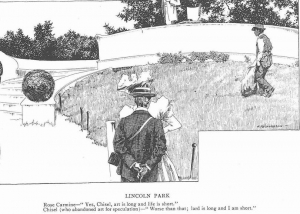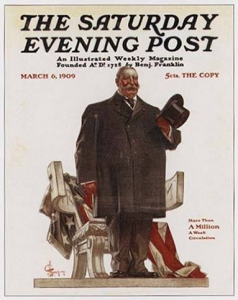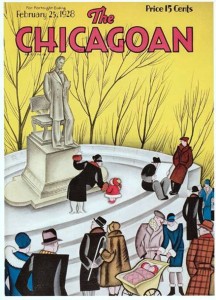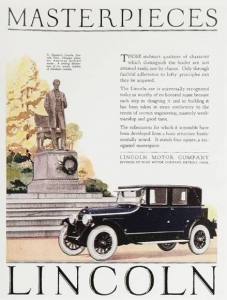
Frederick Richardson (1862-1937) | Lincoln Park, c. 1897 | Editorial cartoon illustration for the Chicago Daily News
The American sculptor Augustus Saint-Gaudens (1848-1907), with assistance from the architect Stanford White (1853 -1906), created the large Standing Lincoln public monument in Lincoln Park, Chicago, Illinois between 1884 and 1887.* The public and critical response to the monument was effusive. In November 1887, Mrs. Mariana Griswold Van Rensselaer wrote a stellar review of the work in The Century Magazine. Then in her 1893 book Art Out-of-Doors, Mrs. Van Rensselaer continued her praise.
“Those who have seen the Chicago Lincoln know how vastly the effect of the figure is increased by the bold yet quiet and dignified character of the substructure, excellently adapted not only to the figure itself but to the chosen site. . . .”**
By the end of the 1890s and until the unveiling of the Lincoln Monument on the Mall in Washington, DC in 1922, the Standing Lincoln had so completely become an American icon that a variety of American illustrators used it or referred to it in their own work created both for the specific Chicago market and some for the national market.
One of the earliest illustrations that references this Lincoln was the editorial cartoon seen above by Frederick Richardson. A Chicago native who was trained at the St. Louis Art School, Richardson was a newspaper artist for the Chicago Daily News and was also an instructor at the School of the Art Institute of Chicago. His reference to the Lincoln Park monument is easily seen in the title of the two line quip under the image that juxtaposes the English version of a Latin proverb, ‘art is long and life is short,’ to a stock market speculator’s version that ‘lard is long and I am short.’ What I find most intriguing about Richardson’s image for this piece is that he visually restricts the reference to the monument to almost completely picturing the stair approach to the raised platform that holds the standing figure on his pedestal and the exedra seat that surrounds the platform while showing the figure only from its knees to its waist standing before the great classical-style klismos chair. The implication of this abbreviated image is that Chicagoans will recognize the monument site from what is shown, and if they need prompting, the title of the quip, Lincoln Park, will provide sufficient information.
Miles W. Sater (early 20th century); Postcard, Lincoln Monument in Lincoln Park, c1920; Illustration for Art-Lover’s Chicago, Volland Views, P. F. Volland & Co., Chicago,U. S. A.; See, https://chuckmancollectionvolume15.blogspot.com/2009/08/postcard-chicago-volland-sater-series.html
As you can see in the above postcard’s watercolor image, the monument’s environment is clearly understood as part of the whole. So much so that as when Richardson used it to identify the location, it was recognizable to the Chicago public but also likely to a larger national audience. In 1913, the Chicago Record-Herald reported that in a national contest this Lincoln monument was voted “the greatest work of sculpture inAmerica.”***
J. C. Leyendecker (1874-1951); Inauguration of Wm. Howard Taft, 1909; Cover for The Saturday Evening Post (March 6, 1909)
In the spring of 1909 the illustrator J. C. Leyendecker made an oblique reference to the Standing Lincoln monument in his cover illustration marking the inauguration of William Howard Taft as president. Leyendecker painted the huge president standing in front of a flag-draped over-sized klismos chair in a pose echoing Saint-Gaudens’ Standing Lincoln poised in front of his klismos, meant to be seen as the chair of state. Where Lincoln’s raised proper left arm holds the lapel of his coat, Taft instead holds his top hat worn for the inauguration. Although by 1909 J. C. Leyendecker was living and working in metropolitan New York, in 1887, when the Lincoln was unveiled in Chicago’s Lincoln Park, J. C. Leyendecker was 13 years old and his family had been settled in Chicago for five years after they emigrated from Germany. It is clear from a variety of examples that Leyendecker was familiar with Saint-Gaudens’ sculptural work.
Constantin Alajalov (1900-1987); February 12, 1928; Cover illustration for The Chicagoan (February 25, 1928)
The Russian-born illustrator Constantin Alajalov created the above cover of The Chicagoan magazine in honor of the anniversary of Lincoln’s birth in 1928, only a few years after he’d emigrated to New York City. No doubt it was created from photographs of the popular monument at the behest of the magazine’s editors, since it was unlikely that Alajalov had visited Chicago yet. Two years later, illustrator Harold Peterson created another Lincoln cover illustration for The Chicagoan magazine, The Park Lincoln.****
Unknown Illustrator; Masterpieces Lincoln, c. 1920s; Advertisement for Lincoln Motor Company, Division of Ford Motor Company, Detroit, Michigan
Further proof of the visual ubiquity of Saint-Gaudens’ Lincoln monument can be seen in Lincoln Motor Company’s 1920s ad focused on the equivalency of the monument and their luxury automobile of the same name. True, the unknown illustrator of this ad compressed the architectural environment—reducing the number of steps up to the platform, obliterating the stone exedra seat, the low walls at the outer edges of the stairs, and the bronze spheres placed at the bottom of the low stair walls. But most important, the ad’s copy writer included a caption for the monument above the figure’s head, just in case you might not recognize this, “the greatest work of sculpture in America.”
* This monument is properly called Abraham Lincoln: The Man. It was unveiled to the public on October 22, 1887.
** Mrs. Schuyler [Mariana Griswold] Van Rensselaer, Art Out-of-Doors: Hints on Good Taste in Gardening (New York: Charles Scribner’s Sons, 1893): 211.
*** Diana Stazdes, “Recasting history: word and image in Augustus Saint-Gaudens’s Standing Lincoln monument,” Word & Image v. 26 no. 2 (April-June 2010): 128.
**** Cover illustration for The Chicagoan (February 15, 1930) called The Park Lincoln by Harold Peterson.
October 18, 2012
By Joyce K. Schiller, Curator, Rockwell Center for AmericanVisual Studies, Norman Rockwell Museum










